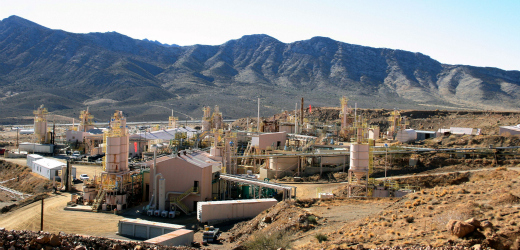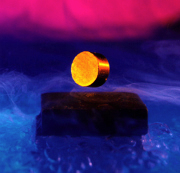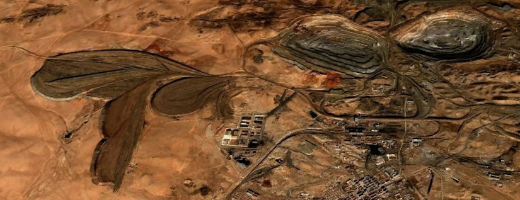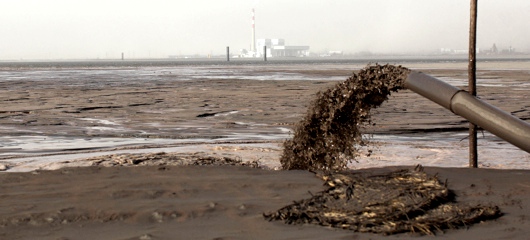What are rare earth metals?
They're crucial to hybrid cars, wind turbines and many other
green-tech innovations, but these elusive metals also have
an environmental dark side.
Wed, Jun 22 2011

 Permanent
magnets are another big role for rare earths. Their light
weight and high magnetic strength have made it possible to
miniaturize a wide range of electronic parts, including many
used in home appliances, audio/video equipment, computers,
cars and military gear. Innovations like small,
multi-gigabyte jump drives and DVD drives likely wouldn't
exist without rare earth magnets, which are often made from
a neodymium alloy but may also contain
praseodymium,
samarium,
gadolinium or
dysprosium.
Permanent
magnets are another big role for rare earths. Their light
weight and high magnetic strength have made it possible to
miniaturize a wide range of electronic parts, including many
used in home appliances, audio/video equipment, computers,
cars and military gear. Innovations like small,
multi-gigabyte jump drives and DVD drives likely wouldn't
exist without rare earth magnets, which are often made from
a neodymium alloy but may also contain
praseodymium,
samarium,
gadolinium or
dysprosium.


 Molycorp
is allowed to deepen its pit at Mountain Pass (pictured) by
an extra 300 feet over the next 30 years, which could boost
global supplies of rare earths by 10 percent a year. And
it's not the only company itching to tap U.S. reserves:
Wings Enterprises is reviving its Pea Ridge mine in
Missouri, for instance, while a new mine in Wyoming may open
as early as 2014. Overall, experts say the growth of rare
earth mining is all but inevitable, adding a toxic asterisk
to many technologies designed to fight climate change.
Molycorp
is allowed to deepen its pit at Mountain Pass (pictured) by
an extra 300 feet over the next 30 years, which could boost
global supplies of rare earths by 10 percent a year. And
it's not the only company itching to tap U.S. reserves:
Wings Enterprises is reviving its Pea Ridge mine in
Missouri, for instance, while a new mine in Wyoming may open
as early as 2014. Overall, experts say the growth of rare
earth mining is all but inevitable, adding a toxic asterisk
to many technologies designed to fight climate change.
"Rare earth" metals aren't as rare as they sound — in fact,
you're probably using some right now. They're key to a
variety of everyday devices, from tablet computers and TVs
to hybrid cars and wind turbines, so it may be encouraging
to know several kinds are actually common.
Cerium, for example, is the 25th most abundant element
on Earth.
So why are they called "rare" earths? The name alludes to
their elusive nature, since the
17 elements rarely exist in pure form. Instead, they mix
diffusely with other minerals underground, making them
costly to extract.
And, unfortunately, that isn't their only drawback. Mining
and refining rare earths makes an
environmental mess, leading most countries to neglect
their own reserves, even as demand soars. China has been the
main exception since the early 1990s, dominating global
trade with its willingness to intensively mine rare earths —
and to deal with their acidic, radioactive byproducts.
That's why the U.S., despite large deposits of its own,
still gets 92 percent of its rare earths from China.
This wasn't a problem until recently, when China began
tightening its grip on rare earths. The country first
imposed trade limits in 1999, and its exports shrank by 20
percent from 2005 to 2009. They then took a dramatic
nosedive in 2010, squeezing global supplies amid a dispute
with Japan, and they've
fallen even further in 2011. China says it's being
stingy for
environmental reasons, not economic leverage, but the
cutbacks have nonetheless caused major price spikes. The
price of
neodymium hit $129 per pound in May, for example, up
from just $19 a year earlier.
Many of China's customers are already shopping around:
Deposits in Russia, Brazil, Australia and South Asia have
drawn widespread interest, as has the only rare earths mine
in the U.S. But even though that mine reopened in April
after a decade-long hiatus — and holds the largest rare
earth deposit outside China — the U.S., like many countries,
doesn't want to be the world's new go-to source for rare
earths. "Diversified global supply chains are essential,"
the Energy Department said in a
2010 report.

The newly reopened
rare earths mine in Mountain Pass, Calif., pictured here in
December 2010.
Why are so many countries reluctant to exploit their own
rare earth reserves? And what makes rare earths so unique to
begin with? For answers to these and other questions, check
out the following overview of these 17 mysterious metals.
A rare breed
Much of rare earths' appeal lies in their ability to perform
obscure, highly specific tasks.
Europium provides red phosphor for TVs and computer
monitors, for example, and it has no known substitute.
Cerium similarly rules the glass-polishing industry, with
"virtually all polished glass products" dependent on it,
according to the U.S. Geological Survey.
 Permanent
magnets are another big role for rare earths. Their light
weight and high magnetic strength have made it possible to
miniaturize a wide range of electronic parts, including many
used in home appliances, audio/video equipment, computers,
cars and military gear. Innovations like small,
multi-gigabyte jump drives and DVD drives likely wouldn't
exist without rare earth magnets, which are often made from
a neodymium alloy but may also contain
praseodymium,
samarium,
gadolinium or
dysprosium.
Permanent
magnets are another big role for rare earths. Their light
weight and high magnetic strength have made it possible to
miniaturize a wide range of electronic parts, including many
used in home appliances, audio/video equipment, computers,
cars and military gear. Innovations like small,
multi-gigabyte jump drives and DVD drives likely wouldn't
exist without rare earth magnets, which are often made from
a neodymium alloy but may also contain
praseodymium,
samarium,
gadolinium or
dysprosium.
While producing rare earths can cause environmental
problems, they have an eco-friendly side, too. They're vital
to catalytic converters, hybrid cars and wind turbines, for
example, as well as energy-efficient fluorescent lamps and
magnetic-refrigeration systems. Their low toxicity is an
advantage, too, with lanthanum-nickel-hydride batteries
slowly replacing older kinds that use cadmium or lead. Red
pigments from
lanthanum or cerium are also phasing out dyes that
contain various toxins. (For more information, see the list
below of
rare earth metals and their uses.)
Lots of green technologies rely on rare earths, but
ironically, rare earth producers have a long history of
harming the environment to get the metals. Like many
industries that process mineral ores, they end up with toxic
byproducts known as "tailings," which can be contaminated
with radioactive uranium and thorium. In China, these
tailings are often dumped into "rare
earth lakes" like the ones pictured below:

Satellite view of
China's Baotou rare earths complex. Mines are at top right;
waste lakes are at left.

Ground-level view
of wastewater being pumped into a rare earth lake at Baotou.
As the AFP
reports, farmers near China's Baotou mine complain of
dying crops, lost teeth and lost hair, while soil and water
tests show high levels of carcinogens in the area. China has
only recently begun
cracking down on such pollution, perhaps learning a
lesson from Mountain Pass, Calif., which supplied most of
the world's rare earths until economic and environmental
pressures forced it to close in 2002. The mine's profits had
declined for years as China slashed rare earth prices with
its own mining frenzy, while a series of wastewater leaks
from 1984 to 1998 spilled thousands of gallons of toxic
sludge into the California desert, sullying the mine's
public image.
But as China's output now declines, rising prices have once
again opened the door for Mountain Pass. In April,
Molycorp Minerals hosted an event heralding the return
of its idle mine, which some politicians say is key to
reducing U.S. reliance on imports. "We must wean
ourselves off our total dependence on China for rare
earths," Rep. Mike Coffman, R-Colo., recently told the
Financial Times. It's hard to disagree, given rare earths'
global importance, but the specter of spills still lingers.
Molycorp knows that,
CEO Mark Smith told the Atlantic in 2009, and aims to be
"environmentally superior, not just compliant." The company
is spending $2.4 million a year on monitoring and
compliance, which raises costs, but Smith says that won't
deter anxious buyers. "We're being contacted by Fortune 100
companies who are worried about where they're going to get
their next pound of [rare earths]," he
told Bloomberg News in January. "What they want to talk
to us about is long-term, stable, secure supplies."
 Molycorp
is allowed to deepen its pit at Mountain Pass (pictured) by
an extra 300 feet over the next 30 years, which could boost
global supplies of rare earths by 10 percent a year. And
it's not the only company itching to tap U.S. reserves:
Wings Enterprises is reviving its Pea Ridge mine in
Missouri, for instance, while a new mine in Wyoming may open
as early as 2014. Overall, experts say the growth of rare
earth mining is all but inevitable, adding a toxic asterisk
to many technologies designed to fight climate change.
Molycorp
is allowed to deepen its pit at Mountain Pass (pictured) by
an extra 300 feet over the next 30 years, which could boost
global supplies of rare earths by 10 percent a year. And
it's not the only company itching to tap U.S. reserves:
Wings Enterprises is reviving its Pea Ridge mine in
Missouri, for instance, while a new mine in Wyoming may open
as early as 2014. Overall, experts say the growth of rare
earth mining is all but inevitable, adding a toxic asterisk
to many technologies designed to fight climate change.
But there may be one way to reduce demand for new mining:
rare earth recycling. China's export policies have led
some Japanese companies to recycle rare earths, such as
Mitsubishi, which is studying the cost of reusing neodymium
and dysposium from washing machines and air conditioners.
Hitachi, which uses up to 600 tons of rare earths each year,
expects recycling to fill 10 percent of its needs by 2013.
The U.N. also
recently launched a project to track discarded "e-waste"
like cellphones and TVs, hoping to boost recycling not only
of rare earths but also gold, silver and copper. Yet until
such programs are more cost-effective, the U.S. and other
countries will almost certainly keep testing just how rare —
and how safe — rare earths really are.
See the list below to learn more about how each of the
17 rare earth minerals are used, or skip to the bottom of
the page for
links to more information.
Rare earths roster
-
 Scandium: Added
to mercury vapor lamps to make their light look more like
sunlight. Also used in certain types of athletic equipment —
including aluminum baseball bats, bicycle frames and
lacrosse sticks — as well as fuel cells.
Scandium: Added
to mercury vapor lamps to make their light look more like
sunlight. Also used in certain types of athletic equipment —
including aluminum baseball bats, bicycle frames and
lacrosse sticks — as well as fuel cells. -
 Yttrium: Produces
color in many TV picture tubes. Also conducts microwaves and
acoustic energy, simulates diamond gemstones, and
strengthens ceramics, glass, aluminum alloys and magnesium
alloys, among other uses.
Yttrium: Produces
color in many TV picture tubes. Also conducts microwaves and
acoustic energy, simulates diamond gemstones, and
strengthens ceramics, glass, aluminum alloys and magnesium
alloys, among other uses. -
 Lanthanum:
One of several rare earths used to make carbon arc
lamps, which the film and TV industry use for studio and
projector lights. Also found in batteries, cigarette-lighter
flints and specialized types of glass, like camera lenses.
Lanthanum:
One of several rare earths used to make carbon arc
lamps, which the film and TV industry use for studio and
projector lights. Also found in batteries, cigarette-lighter
flints and specialized types of glass, like camera lenses. -
 Cerium:
The most widespread of all rare earth metals. Used in
catalytic converters and diesel fuels to reduce vehicles'
carbon monoxide emissions. Also used in carbon arc lights,
lighter flints, glass polishers and self-cleaning ovens.
Cerium:
The most widespread of all rare earth metals. Used in
catalytic converters and diesel fuels to reduce vehicles'
carbon monoxide emissions. Also used in carbon arc lights,
lighter flints, glass polishers and self-cleaning ovens. -
 Praseodymium:
Primarily used as an alloying agent with magnesium to
make high-strength metals for aircraft engines. Also may be
used as a signal amplifier in fiber-optic cables, and to
create the hard glass of welder's goggles.
Praseodymium:
Primarily used as an alloying agent with magnesium to
make high-strength metals for aircraft engines. Also may be
used as a signal amplifier in fiber-optic cables, and to
create the hard glass of welder's goggles. -
 Neodymium:
Mainly used to make powerful neodymium magnets for
computer hard disks, wind turbines, hybrid cars, earbud
headphones and microphones. Also used to color glass and to
make lighter flints and welder's goggles.
Neodymium:
Mainly used to make powerful neodymium magnets for
computer hard disks, wind turbines, hybrid cars, earbud
headphones and microphones. Also used to color glass and to
make lighter flints and welder's goggles. -
 Promethium:
Does not occur naturally on Earth; must be artificially
produced via uranium fission. Added to some kinds of
luminous paint and nuclear-powered microbatteries, with
potential use in portable X-ray devices.
Promethium:
Does not occur naturally on Earth; must be artificially
produced via uranium fission. Added to some kinds of
luminous paint and nuclear-powered microbatteries, with
potential use in portable X-ray devices. -
 Samarium:
Mixed with cobalt to create a permanent magnet with the
highest demagnetization resistance of any known material.
Crucial for building "smart" missiles; also used in carbon
arc lamps, lighter flints and some types of glass.
Samarium:
Mixed with cobalt to create a permanent magnet with the
highest demagnetization resistance of any known material.
Crucial for building "smart" missiles; also used in carbon
arc lamps, lighter flints and some types of glass. -
 Europium:
The most reactive of all rare earth metals. Used for
decades as a red phosphor in TV sets — and more recently in
computer monitors, fluorescent lamps and some types of
lasers — but otherwise has few commercial applications.
Europium:
The most reactive of all rare earth metals. Used for
decades as a red phosphor in TV sets — and more recently in
computer monitors, fluorescent lamps and some types of
lasers — but otherwise has few commercial applications. -
 Gadolinium: Used
in some control rods at nuclear power plants. Also used in
medical applications such as magnetic resonance imaging
(MRI), and industrially to improve the workability of iron,
chromium and various other metals.
Gadolinium: Used
in some control rods at nuclear power plants. Also used in
medical applications such as magnetic resonance imaging
(MRI), and industrially to improve the workability of iron,
chromium and various other metals. -
 Terbium:
Used in some solid-state technology, from advanced sonar
systems to small electronic sensors, as well as fuel cells
designed to operate at high temperatures. Also produces
laser light and green phosphors in TV tubes.
Terbium:
Used in some solid-state technology, from advanced sonar
systems to small electronic sensors, as well as fuel cells
designed to operate at high temperatures. Also produces
laser light and green phosphors in TV tubes. -
 Dysprosium:
Used in some control rods at nuclear power plants. Also
used in certain kinds of lasers, high-intensity lighting,
and to raise the coercivity of high-powered permanent
magnets, such as those found in hybrid vehicles.
Dysprosium:
Used in some control rods at nuclear power plants. Also
used in certain kinds of lasers, high-intensity lighting,
and to raise the coercivity of high-powered permanent
magnets, such as those found in hybrid vehicles. -
 Holmium:
Has the highest magnetic strength of any known element,
making it useful in industrial magnets as well as some
nuclear control rods. Also used in solid-state lasers and to
help color cubic zirconia and certain types of glass.
Holmium:
Has the highest magnetic strength of any known element,
making it useful in industrial magnets as well as some
nuclear control rods. Also used in solid-state lasers and to
help color cubic zirconia and certain types of glass. -
 Erbium:
Used as a photographic filter and as a signal amplifier (aka
"doping agent") in fiber-optic cables. Also used in some
nuclear control rods, metallic alloys, and to color
specialized glass and porcelain in sunglasses and cheap
jewelry.
Erbium:
Used as a photographic filter and as a signal amplifier (aka
"doping agent") in fiber-optic cables. Also used in some
nuclear control rods, metallic alloys, and to color
specialized glass and porcelain in sunglasses and cheap
jewelry. -
 Thulium:
The rarest of all naturally occurring rare earth metals. Has
few commercial applications, although it is used in some
surgical lasers. After being exposed to radiation in nuclear
reactors, it's also used in portable X-ray technology.
Thulium:
The rarest of all naturally occurring rare earth metals. Has
few commercial applications, although it is used in some
surgical lasers. After being exposed to radiation in nuclear
reactors, it's also used in portable X-ray technology. -
 Ytterbium:
Used in some portable X-ray devices, but otherwise has
limited commercial uses. Among its specialty applications,
it's used in certain types of lasers, stress gauges for
earthquakes, and as a doping agent in fiber-optic cables.
Ytterbium:
Used in some portable X-ray devices, but otherwise has
limited commercial uses. Among its specialty applications,
it's used in certain types of lasers, stress gauges for
earthquakes, and as a doping agent in fiber-optic cables. -
 Lutetium: Mainly
restricted to specialty uses, such as calculating the age of
meteorites or performing positron emission tomography (PET)
scans. Has also been used as a catalyst for the process of
"cracking" petroleum products at oil refineries.
Lutetium: Mainly
restricted to specialty uses, such as calculating the age of
meteorites or performing positron emission tomography (PET)
scans. Has also been used as a catalyst for the process of
"cracking" petroleum products at oil refineries.
Copyright © 2013 MNN
Holdings, LLC. All Rights Reserved.
http://www.mnn.com/earth-matters/translating-uncle-sam/stories/what-are-rare-earth-metals
http://www.mnn.com/earth-matters/translating-uncle-sam/stories/what-are-rare-earth-metals